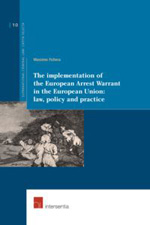The implementation of the European Arrest Warrant in the European Union
Law, policy and practice
- ISBN: 9789400001725
- Editorial: Intersentia Ltd.
- Fecha de la edición: 2011
- Lugar de la edición: Antwerp. Bélgica
- Colección: Supranational criminal Law: Capita Selecta
- Encuadernación: Rústica
- Medidas: 24 cm
- Nº Pág.: 253
- Idiomas: Inglés

This book provides a critical analysis of the principle of mutual recognition of judicial decisions in criminal matters in the EU, through a detailed assessment of its most prominent instrument, the European Arrest Warrant (EAW). It conceptualises and contextualises the lack of clear vision in the building up of the area of freedom, security and justice from an EU constitutional law, as well as a comparative and international criminal law standpoint. The EAW is considered both as a test for all the other measures which have been adopted or will be adopted as part of the mutual recognition agenda, and as an evolution of classic extradition. On the one hand, its significance is viewed from the perspective of both EU law and international law, by highlighting the structural deficiencies of the former Third Pillar and the need to remedy them. On the other hand, its impact is verified not only in the context of European cooperation in criminal matters, but also in light of the more general question of the identity of the EU as a polity as well as the nature and implications of EU integration after the entry into force of the Treaty of Lisbon. In particular, this work revolves around four main issues: first, the need to substantially re-define the concept of mutual recognition; second, the extent to which the new mechanism of the EAW effectively operates within a non-harmonised landscape; third, the exact nature and scope of mutual trust, as a notion that underpins the principle of mutual recognition in European criminal law; and finally, the tension between the need to enhance the law enforcement aspects of EU cooperation and the urge to build up a common framework of procedural rights. An overview of the implementation of the EAW in the UK and Italy, as examples of a common law and a civil law jurisdiction, is also offered. The book is aimed primarily at academics from different backgrounds both within and outside Europe. Those with an expertise in international crimina






